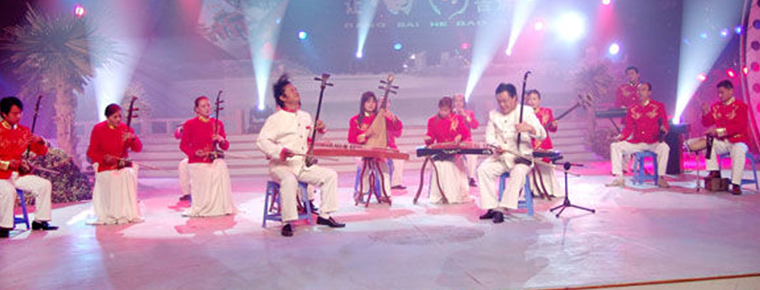Major tune
Major tune
The major tune was originally called "drum tune". Varieties of Quyiqu. It was first prevalent in Kaifeng, Henan Province, and then spread to Luoyang, Nanyang and other places. It has a history of about 200 years. By the end of the Qing Dynasty and the beginning of the Republic of China, the artists who sang drum tunes used various kinds of miscellaneous tunes with concise melodies and easy to speak to make folk dance and singing when walking on stilts, which was called minor tunes, the predecessor of Henan Opera. At that time, the drum tunes in Kaifeng and Luoyang area gradually declined because of the prosperity of minor tunes, while the drum tunes in Nanyang area not only remained, but also had new development, which is the major tunes that have been developed so far. It has more than 200 opera cards, which can be divided into three categories: big, Kun and miscellaneous. There are two types of music structure: singles and combination of Qupai. The accompaniment instruments are mainly plucked instruments, such as three strings, Pipa and Zheng. The percussion instruments include sandalwood board and octagonal drum. In the old days, there were no professional artists. Most of them were amateurs singing around the table during their breaks, and they cut each other's skills. After liberation, professional actors were trained and put on the stage.
historical origin
From Ming and Qing folk songs. After the Guziqu of Bianliang was introduced into Nanyang, it absorbed some pieces of Shaanxi Quzi and Hubei Xiaoqu. After it was introduced into Nanyang during the Qianlong reign of Qing Dynasty, it gradually formed a variety of tunes different from Kaifeng Guzi tune. It absorbed the local opera tunes after Qianlong, such as "Shipai Tune", "Blowing Tune", "Xipi Tune" and "Erhuang Tune", and formed Nanyang Major tune different from Kaifeng Drum Tune.
In the 1930s, drum tunes were renamed major tunes because Henan operas were commonly known as minor tunes. Nanyang Major has a long history. Singing was performed in the Ming Dynasty. During the Qing Dynasty and the Republic of China, Nanyang Major tunes were frequently sung. After the founding of the People's Republic of China, Nanyang major tunes have been greatly developed. In the 1960s, Nanyang's quyi writers created a large number of new tunes. Most of the tunes in Nanyang Major were rhyme style, short lyrics, and a few of the life tunes were added with narration.


-
1.Huizhou cake
Huizhou cake, originally named "jujube mud crisp baked bread", is a traditional feature in Huizhou area, Anhui Province.
Time 2018-11-27 -
2.Beigushan HillBeigu Mountain
Beigu Mountain, one of the three scenic spots in Zhenjiang, overlooks Beigu, pillows the river, rocky walls, and the mountain is dangerous, so it is named Beigu Mountain
Time 2018-12-06 -
3.Root palace Buddhist Cultural Tourism Zone
Root palace Buddhist Cultural Tourism Zone / Gengong Buddha Country Cultural Tourist Area, National AAAAA Tourist Scenic Area, National Eco-civilization Education Base
Time 2018-12-07 -
4.Guanlan Lake Leisure Tourist Area
Shenzhen Guanlanhu Leisure Tourist Area, in May 2011, was awarded the National 5A Tourist Scenic Area, located in Shenzhen, Guangdong Province.
Time 2018-12-12 -
5.Xiantan Mountain Hot Spring Town
Xiantan Mountain Hot Spring Town is located in Xiwangzhuang Town, Zaozhuang City, Shandong Province. It is on the west side of Zaoji S345 Highway, south of Taierzhuang Ancient City, and on the side of
Time 2018-12-22 -
6.Bezeklik Thousand Buddha Caves
The Qianfo Cave in Bozikrik is located on the cliff on the West Bank of the Wood Trench, 45 kilometers east of Turpan City, Xinjiang. There are 83 caves and 57 caves
Time 2019-01-02 -
7.Qufuming Old Town
Qufuming Old Town: World Cultural Heritage, one of the three holy cities in the world, national AAAAA tourist attractions, National Scenic spots, national key cultural relics protection units, one of
Time 2019-02-07 -
8.Construction Techniques of Wood Construction of Dong Nationality
Dong's wood construction and construction skills, the traditional architectural skills of Sanjiang Dong Autonomous County, Guangxi Zhuang Autonomous Region, one of the national intangible cultural her
Time 2019-04-28 -
9.Shandong Express Book
Shandong Quick Book, originating from Shandong Province's local traditional folk art form, has a history of more than 100 years. It was first popular in Shandong, North China and Northeast China, and
Time 2019-06-13 -
10.Yi opera
Yi Opera, a local traditional drama in Dayao County, Yunnan Province, is one of the national intangible cultural heritage.
Time 2019-07-12 -
11.Junlian karst
Junlian karst scenic area. Located in Junlian County, Yibin City. The scenic area covers 130 square kilometers. The main scenic spots include karst peak cluster, box cave, Yuanyang cave, Xianren cave, Mujing hot spring, intermittent spring, etc.
Time 2020-10-16 -
12.Deyang Deyang transportation
By the end of 2018, the total mileage of Deyang highway was 8345.2 km, including 7861.0 km of grade highway, accounting for 94.2% of total highway mileage; 655.8 km of high-grade highway and 205.5 km of expressway. The railway operating
Time 2020-12-14